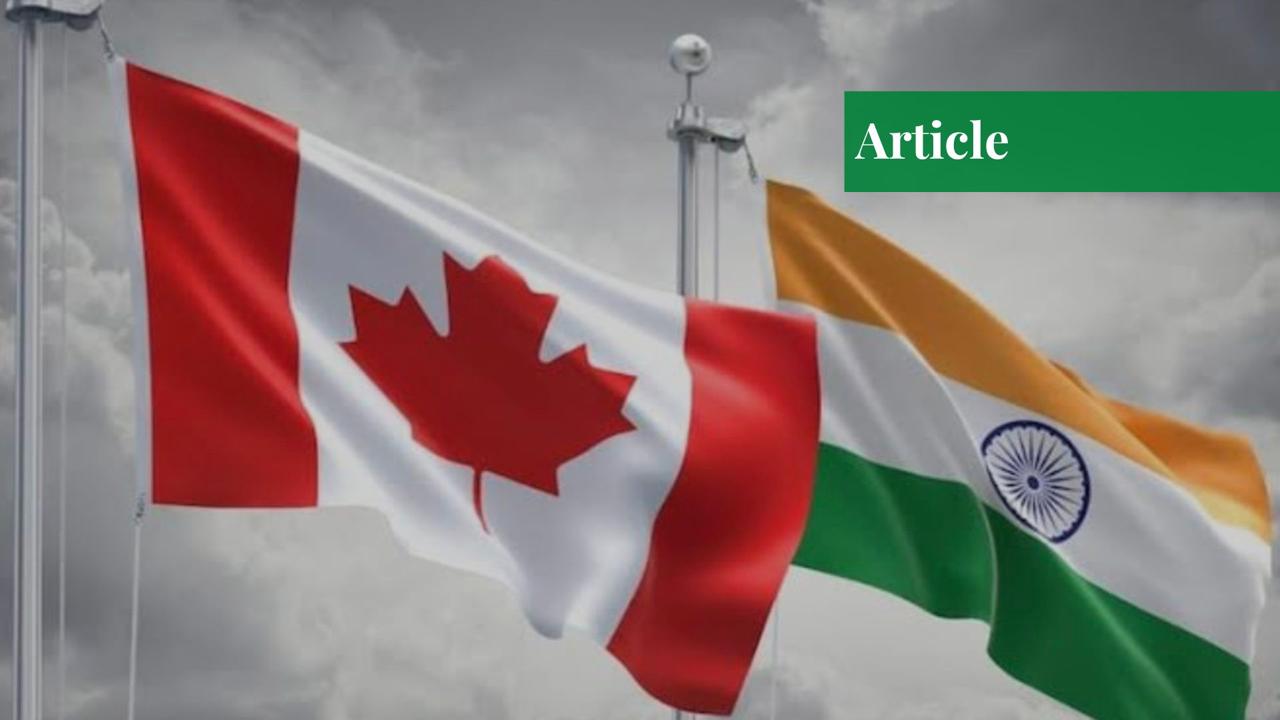Current Situation of the Canada-India Relations
The strained Canada-India relations have reignited after Canadian Prime Minister Justin Trudeau purported that the federal Royal Canadian Mounted Police (RCMP) has unearthed “clear and compelling evidence” against the involvement of the Indian government in activities that threaten public safety. The litany subsumes information-gathering techniques, coercive behavior targeting South Asian Canadians, and participation in over a dozen threatening and violent acts, including murder. This was followed by India’s expulsion of six Canadian diplomats with the pronouncement of withdrawal of its high commissioner from Canada.
On the other hand, Canada also withdrew over two-thirds of its diplomats as a quid pro quo. The situation kicked in last year when Justin Trudeau alleged the involvement of India’s spy agency RAW in hatching an assassination plot against Khalistan’s movement separatist leader Hardeep Nijjar on Canadian soil. Hardeep was declared a terrorist by the Indian government in 2020 for his alleged involvement with the banned terror organization, Khalistan Tiger Force (KTF). He was shot dead in June last year in front of a Sikh temple in Canada.
This reduction in diplomatic staff may impinge on Canadian citizens and Indian students planning to study in Canada by causing delays and limitations in the visa processes. While neither country has levied tariffs or other economic forms of retaliation, experts believe that a cooling relationship between India and Canada could hinder economic growth.
Bilateral Relations Between the Two Countries
Politically, both countries enjoy strategic partnerships that are supported by ministerial dialogues on foreign policy, trade, investment, finance, and energy. This is withheld by several agreements signed between India and Canada, including the Air Services Agreement, Extradition Treaty, Nuclear Cooperation Agreement, and Social Security Agreement. Economically, the total merchandise trade between India and Canada was approximately CAD 12 billion (around USD 8.9 billion) in 2022, marking a substantial 57% increase from the previous year.
India exported goods worth $5.37 billion to Canada, with major products including packaged medicaments, motor vehicles, parts, accessories, and jewelry. On the other hand, Canada exported goods valued at $4.32 billion to India, consisting of coal briquettes, potassium fertilizers, and dried legumes. Furthermore, Canada is the 17th largest country for foreign direct investment (FDI) inflows into India, contributing less than 1% to the total pie. It remains the 8th largest country for India for Foreign Portfolio Investors (FPI), with a 3% share in total FPI inflow.
According to the Ministry of External Affairs, more than 600 Canadian companies have a presence in India, and more than 1,000 Canadian companies are actively pursuing business in the Indian market. Moreover, the two countries also signed the Nuclear Cooperation Agreement (NCA) in June 2010, which resulted in the formation of a Joint Committee on Civil Nuclear Cooperation. This was followed by the signing of an agreement between India’s Atomic Energy Regulatory Board (AERB) and the Canadian Nuclear Safety Commission (CNSC) in 2015 to exchange experiences in nuclear safety and regulatory issues.
Implications for Visa Services for Indian Students
Earlier this month, Canada dented the scores of international student visas, capping them at 360,000 for two years—a 35% decrease from the previous year. Consequently, Indian students, who make up 41% of Canada’s international student population, were severely affected and dropped in number. The National Foundation for American Policy reported that between 2013 and 2023, Indians immigrating to Canada rose from 32,828 to 139,715, an increase of 326 percent. Additionally, Indians enrolling in Canadian universities increased by more than 5,800 percent in the last two decades—from 2,181 in 2000 to 128,928 in 2021. Indian students also represent nearly 40 percent of all international students in Canada.
As per government data from July 2024, 5,853 foreign travelers were denied entry, the highest since 2019. On average, 3,727 travelers were turned away each month in the first seven months of 2024—a 20% rise from last year. This encompassed students, workers, and tourists, with some visa holders who were being declared inadmissible upon arrival.
This is likely to pose significant challenges for new applicants applying for visa services. For instance, Canadian universities are notorious for financially supporting international students, particularly Indians, in their hour of need through their robust framework in the form of international student welfare. Students might be subject to discrimination due to diplomatic row at campuses. Additionally, Indian students gearing to take on their courses in upcoming terms might face delays due to the reduced consular staff.
Economic Implications of Strained Relations
The diplomatic tensions have also contributed to a dramatic decline in Canada’s investment flows to India, from CAD 22 billion in 2021 to just CAD 2.6 billion in 2023—a decrease of about 90%. Additionally, the Comprehensive Economic Partnership Agreement (CEPA), which was aimed at boosting trade by an estimated CAD 3.8 to 5.9 billion by 2035, has been impeded owing to escalating tensions. The agricultural sector of India is also likely to face challenges due to its 25% dependence on Canadian pulse imports (lentils and peas).
Any repulsive measure, particularly from the Canadian side, may raise costs for Indian businesses and complicate supply chains. However, according to the Global Trade Research Initiative (GTRI), despite significant political tensions, trade between India and Canada has remained largely unbothered.
Future of Escalating Tensions
Trudeau’s government is facing significant political pressure and has lost several key by-elections. His administration’s handling of the India situation has been criticized by opposition parties, who alleged that it has jeopardized Canada’s international relations for domestic political gain. Analysts believe that by doing so, he is trying to appease the Sikh community while securing a vote bank for his dwindling support. This must be attributed to the large number of Sikhs living in Canada.
For instance, during the 2021 Census of Population, 771,790 people in Canada reported belonging to the Sikh faith. Upon elections, he is likely to backtrack from animosity towards India on the issue of the Khalistan movement. Additionally, the dent in the diplomatic relations between both countries will impinge on the unity of the Western bloc. India is a crucial ally to the West in countering Chinese influence and also presided over the G20 summit, which ended in the establishment of the new corridor, the India-Middle East-Europe Economic Corridor (IMEC), from India to Europe, mediated by the United States (US) and passing through the Middle East.
Any future confrontation could prove to be a waterloo for the West while providing strategic benefits to China. While they have expressed deep concerns about the Canadian allegation, they can’t afford to lose India. Ergo, current tensions seem transient in the face of the geopolitical and geoeconomic interests of India, Canada, and the rest of the West.
If you want to submit your articles, research papers, and book reviews, please check the Submissions page.
The views and opinions expressed in this article/paper are the author’s own and do not necessarily reflect the editorial position of Paradigm Shift.
Qirat Mirza is currently pursuing her bachelor’s degree in international relations from International Islamic University Islamabad. She is also a writer for Modern Diplomacy, International Affairs Forum, Pakistan Today, KIIR, CISS AJK, and Pak Observer. Recently, she completed a six-week internship at the Kashmir Institute of International Relations and the Inter-Services Public Relations (ISPR) to foster her academic insights and gain practical experience.



